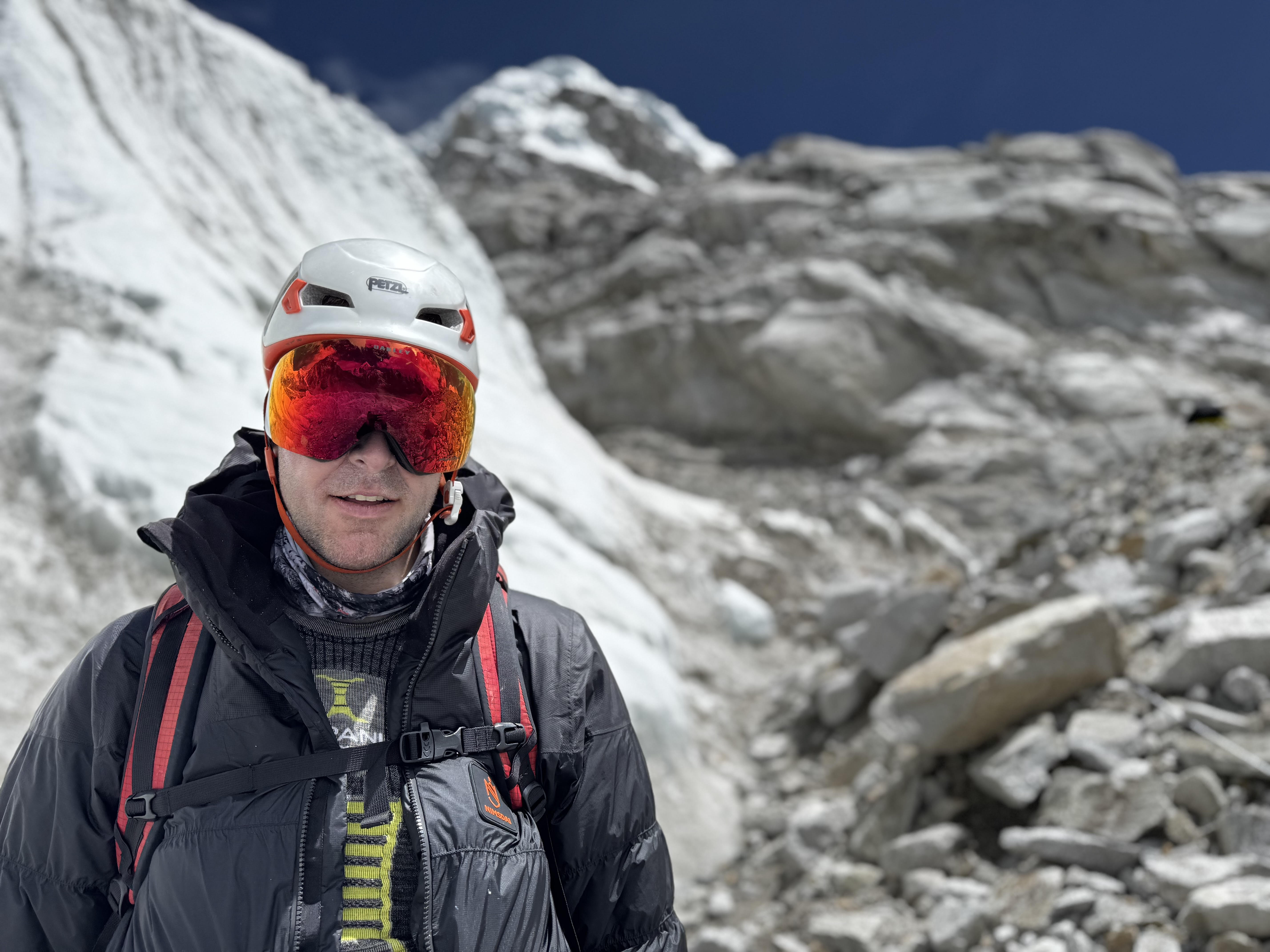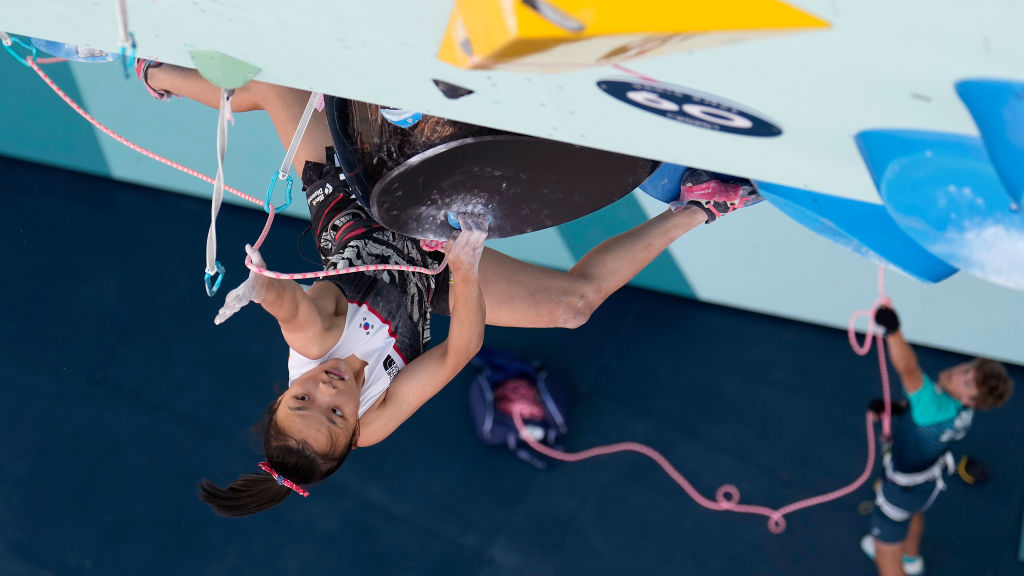"I’m thrilled to have achieved what many people in the mountaineering world said was impossible" – we talk to Andrew Ushakov about his record-breaking Everest summit, along with the altitude specialist behind his time-saving technique
The Ukrainian-American climber puts the success of his sea to summit Everest speed climb down to over 400 hours spent in a hypoxic tent - we got the low down on how he prepared

In a year that will go down in Everest history, Ukrainian-American climber Andrew Ushakov became the fastest person to reach the top of the world's tallest mountain from sea-level, completing the mega-ascent in just three days, 23 hours and 7 minutes.
While all eyes were on a team of four British ex-special forces climbers who had drummed up publicity with their charity bid using Xenon gas, Ushakov quietly completed the ascent just after them, beating their time. What's more, he did it using only supplemental oxygen.
Even more impressive than the fact he completed the expedition while recovering from a broken hand, the time-poor father and engineer did it without acclimatization rotations in the mountains.
We caught up with him to find out the key to his success and his thoughts on the advantages and risks of 'accelerated ascents'.
Posted by eliteexped on
Congratulations on your incredible Everest summit! How are you feeling?
Thank you, I’m good now! The expedition wasn’t as long as traditional 45 to 50-day ones, so I recovered pretty quickly.
You attempted a record-breaking summit in 2024 but were forced to turn back just 300m from the top when you lost your vision. How does it feel in 2025 to have finally succeeded?
I’m thrilled to have achieved what many people in the mountaineering world said was impossible, especially after my 2024 attempt.
I hope it shows that you don’t have to be a professional athlete or a full-time adventurer to do something extraordinary. You can hold down a job, raise a family and still accomplish something that pushes the limits of what you thought was possible.
It’s true, I did it despite having a broken arm – I broke it seven places during a recent avalanche. However, I had been signed off by doctors.
When did you first consider attempting to break the record for fastest sea-level to summit ascent?
It was in July, 2023. After climbing Denali, which took 20 days including the commute from New York where I live, I realized that to be absent from my family and work for 50 days for Everest would be too much.
I started to research and found a story about Roxanne Vogel from California, who did the round trip in 14 days. So I started to work with Dr Irina Zelenkova [a sports medical doctor based in Barcelona] on how to ascend Everest faster than 50 days.
Her initial idea was to do it in three to four weeks, she wasn’t sure if it was possible to do it faster. Roxanne’s accounts say that she used an altitude chamber for preparation on top of a hypoxic tent and mask.
I suggested we should test the methods with a lower mountain – Aconcagua in Argentina, which is 22,841ft (6,962m) in January 2024. I thought that if I could climb it way faster than usual, we would try to attempt the sea-to-summit Everest in 12 days.
So, we started to train, and I climbed Aconcagua in just four days (including the commute from New York). After that, I got a green light from Irina.

The Nepal Department of Tourism is investigating the ascent before verifying it as a record. Are you confident it will be verified?
Yes, I am confident they will be able to verify it as I am able to provide all proof.
You’ve spoken about the advantages of training using a hypoxic tent. We’d love to know more about your experience
Dr Irina Zelenkova helped me along the way. This year, I spent approximately 400 hours in the tent, mostly sleeping in there and working out on a treadmill and StairMaster.
These were my methods:
Sleeping: I put a thick mattress inside the tent, so it was quite comfortable to sleep there.
Working out: To climb a high mountain, you need to do workouts anyway, the only difference with a usual workout was that I wore a mask connected to a generator. I wore the mask at the same time as doing my seven to nine workouts a week. All it takes is just an extra 10 minutes to set things up.
I would compare it with techno-diving [a more challenging form of scuba diving in which you can explore greater depths]: you need some experience prior to diving, but then you can dive way deeper and longer than with a traditional diving approach. It's the same here – a little work prior to climbing, but way faster and safer on the mountain.
What other training did you do?
As well as sleeping in a hypoxic tent and doing workouts on a treadmill, StairMaster and muscular endurance exercise with a mask to simulate altitude, I focused on regular things like diet, sleep, water, fresh air, vitamins.
What would you say to those who are skeptical of training using hypoxic tents, who say they don’t work or that they pose health risks?
Hypoxic tents work – the main goal with this project for me was to show other climbers, that if I, a non-athlete with a broken arm and a shoulder, was able to climb Everest in less than four days, including travelling all the way from New York, other people could climb similar mountains in 10 to 15 days instead of 40 to 50 days.
Regarding health risks, I would say it does the opposite. Rather than posing a risk, sleeping in a tent before going to the mountain is a great health check. If you have hidden health issues, you can discover them at home and can deal with them before you are on the mountain. You can decide to cancel the expedition, instead of risking your life up the mountain.
What’s your response to critics who say your achievement is setting a dangerous example for climbers, or that exploiting the science takes away from the sporting achievement?
I 100% agree, it could be dangerous for other climbers if they want to achieve the same results without putting in the same efforts as I did. I climbed Everest in under four days to demonstrate that this is possible – mostly to myself. In my mind, the safe zone is 10 to 20 days, with six to eight weeks of preparation.
What I have done is to demonstrate that it is possible to avoid spending 40 to 50 days on the mountain, thereby staying away from family and work, by pre-acclimatizing at home.
Why did you choose Elite Exped as your expedition company?
This was my first time with Elite Exped and I highly recommend the company. I am delighted with them. Nimsdai Purja inspired my project with his Project Possible – the quest to summit all 14 peaks over 8,000m (26,247ft) in seven months. He showed that it was possible – the previous record before him was seven years. My project is first of all about showing the way, not setting the record. I climbed without Nimsdai, but with another guide from his team, TJ.
On your return trip you were stopped and arrested at Tribhuvan International Airport for carrying a large amount of undeclared US currency. Can you tell us more about this incident?
I can’t say too much about this. However, I am cooperating fully with all authorities and hope it will be resolved soon.
What's next for you?
Nothing major for now – I need to recover and reflect on what happened first. Probably K2 in 2026. You can follow me on social media and through my website, www.everestseatosummit.com.
Altitude simulation training systems
Andrew Ushakov revealed after his summit that he'd used altitude training technology from specialist company Hypoxico. He said that “the ability to acclimatize at home allowed me to attempt and complete this climb in a fraction of the traditional time.”
We spoke to Hypoxico CEO Brian Oestrike on the realities of training in simulated altitude.

Did you have expectations that such an incredible feat such as Andrew Ushakov's could be achieved using altitude training systems?
We were not aware Andrew was attempting to break a record like this, but we had an inkling based on the protocol and usage questions he was asking that he was working towards something significant. We definitely had the expectation this would happen, the limiting component is how fast you can get to the mountain logistically.
When it comes to preparation, how long before an expedition should a climber start using a hypoxic tent?
This really depends on what the goal is, how high and how long an expedition. It's pretty standard to train and sleep with our systems for about six weeks before a climb, but for taller mountains like Everest it makes sense to go longer. Many of our clients and athletes use our equipment for endurance training. We have olympic level athletes that sleep in our tents around 9,000ft (2,740m) and they do this as long as it's practical, which for many of them, is years. For those training for something like Everest, we usually recommend eight to ten weeks.
Are there negative side effects?
Side effects are pretty similar to real altitude sickness, so if you sleep too high too quickly you basically won't sleep and can even get mild headaches or dehydration.
When did mountaineers first start using hypoxic tents for acclimatization training?
When I was at basecamp in 2008, no one at the time was using hypoxic tents. Everyone was acclimatizing on the mountain. We really didn't see this take off until Adrian Ballinger pioneered the use of the technology to pursue rapid ascents beginning around 2012.
You say there are probably up to 250 clients climbing Everest this season who have trained using hypoxic systems – is this more than ever?
It may be more than 250. The growth in usage has been extensive in the past decade and this is likely the highest rate we've seen on Everest, but the numbers continue to climb.
How will this growth the scene on Everest and other great peaks?
We will see more hypoxic tents in the future and my suspicion is this trend towards shorter expeditions will continue.
- Train indoors or out with the best climbing shoes
- Take your hike to new heights with the best approach shoes

Charlie is a freelance writer and editor with a passion for hiking, biking, wild swimming and active travel. She recently moved from Bristol to South Wales and now refuses to leave her front door without one of the following: lightweight hikers, wetsuit, mountain bike, tent. Having bought a fixer-upper home that backs on to protected woodland, her love of nature and wildlife has intensified and the dark skies have kickstarted a new fondness for stargazing.
